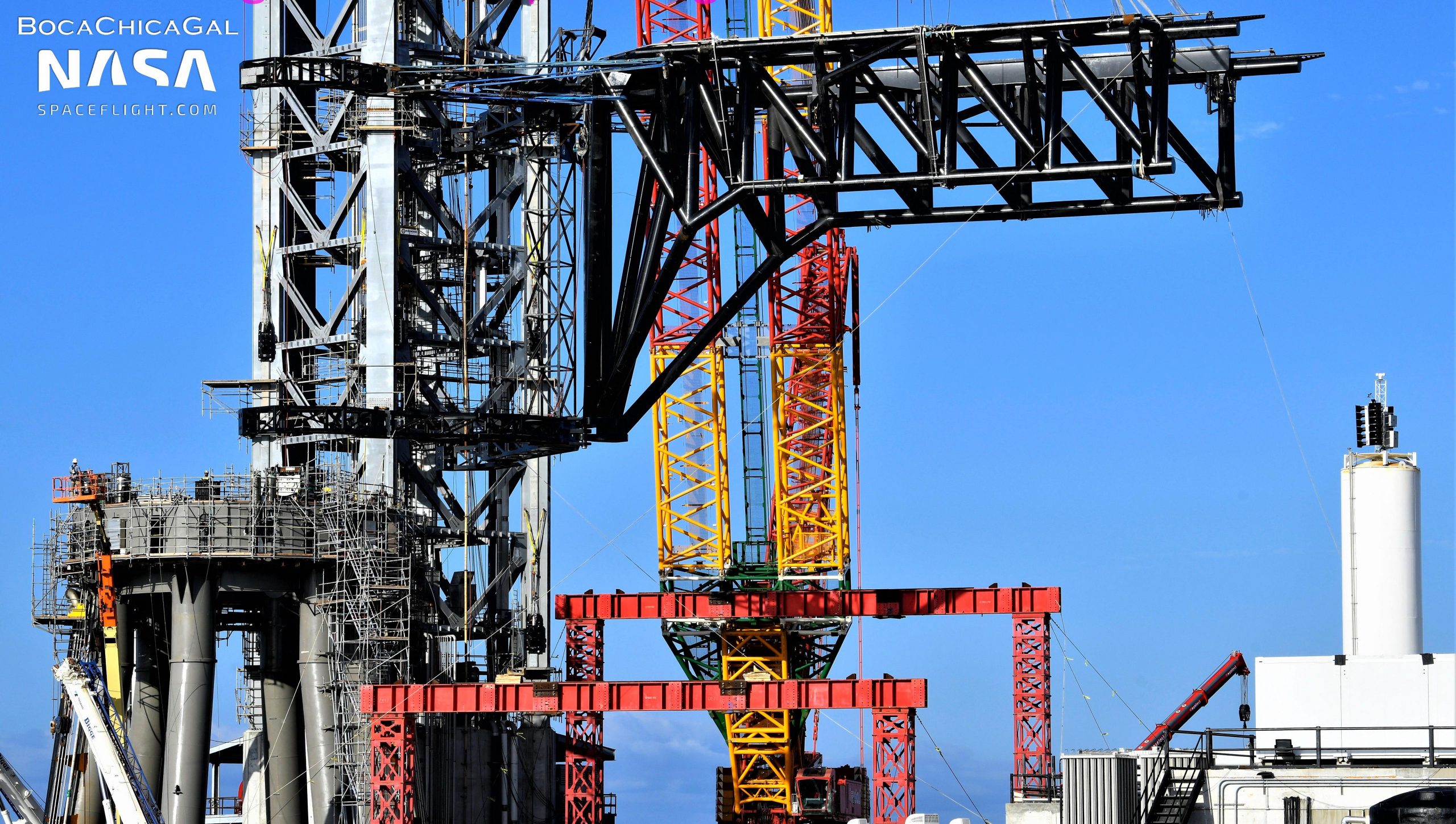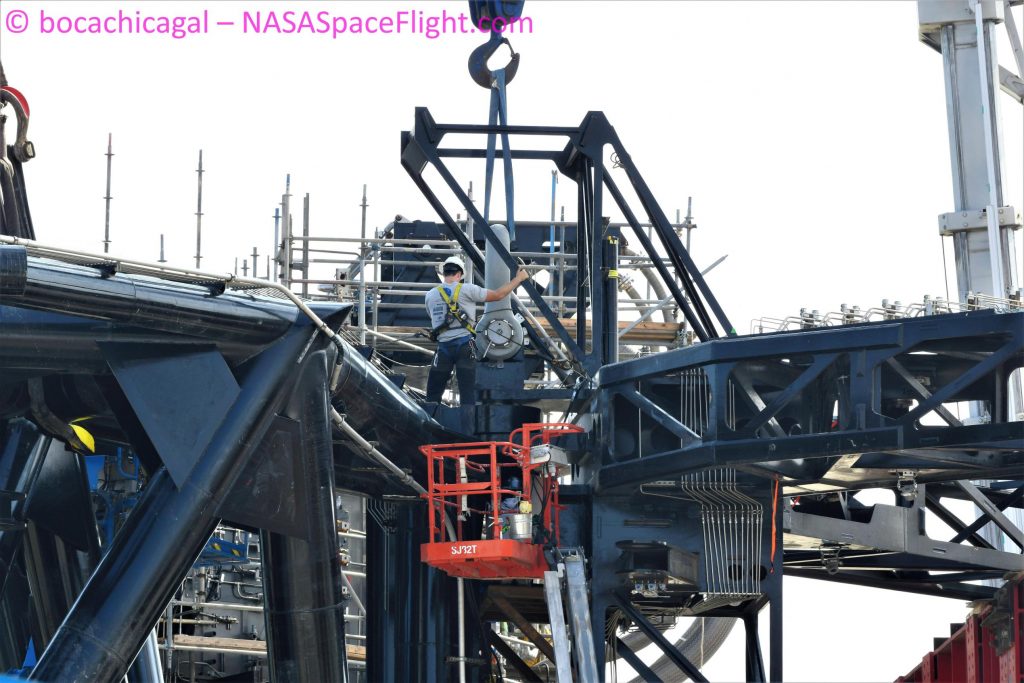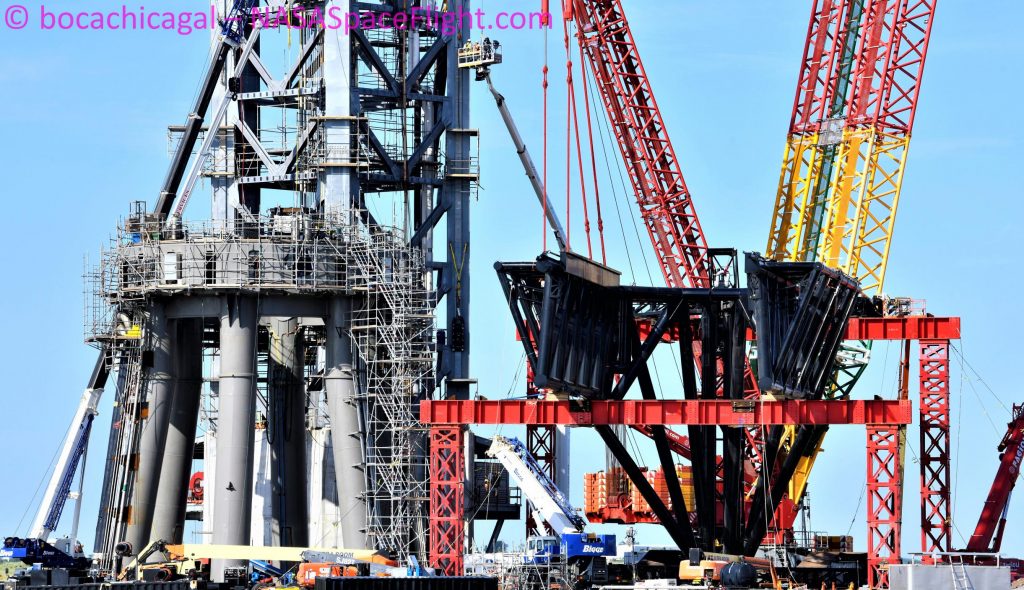

News
SpaceX begins installing ‘Mechazilla’ arms designed to catch Starship rockets
After a busy few weeks spent attaching Mechazilla’s two rocket-catching arms to a carriage-like backbone, SpaceX has begun the process of installing the integrated structure on Starbase’s ~450 ft (~135m) tall Starship ‘launch tower’.
Once complete, SpaceX will have created a first-of-its-kind launch tower designed to stack and manipulate Starships and Super Heavy boosters in far worse conditions than cranes can tolerate and catch both rocket stages out of mid-air. Referred to internally as ‘chopsticks,’ the giant pair of steel arms will join a third ‘quick disconnect’ (QD) arm tasked with stabilizing Super Heavy during Starship installation and feeding the reusable upper stage power, comms links, and some 1200 tons (~2.65M lb) of propellant.
Together, they will enable SpaceX to attempt Starship’s first orbital test flights and, perhaps one day, help the next-generation rocket launch in almost any weather and achieve unprecedentedly rapid reusability. But first, SpaceX needs to finish installing and rigging the massive structure.
Beginning on August 29th after less than three months of assembly, SpaceX installed Starship’s QD arm on the launch tower. About a month later, the QD arm was mostly finished off with the installation of a claw-like grabber meant to stabilize Super Heavy and is now only missing its namesake quick-disconnect (an actuating device that will connect Starship to the pad and rapidly disconnect at liftoff). Assembly of the last three major components of Mechazilla – a carriage-like structure and two giant arms – began in July and, much like the tower’s QD arm, wrapped up about three months later.
On October 6th, SpaceX began combining those three main parts by flipping the carriage – a bit like a spine and ribcage with ‘skates’ that attach to rails on the launch tower’s legs – vertical and staging it on a temporary support structure. Both ‘chopsticks’ were then flipped into the correct orientation and moved into position with separate cranes for installation on the carriage/backbone. From start to finish, that process took around 9-10 days and culminated with the installation of two giant cylindrical pins with built-in bearings on October 14th and 15th. By the 17th, both cranes had detached from the assembled Mechazilla arms and carriage were, leaving it precisely balanced against the support structure and more or less freestanding.


Just a few days later, after a last-second attempt on October 19th was called off as night fell, SpaceX tried again on the 20th and completed the first step of installing Mechazilla’s catch arms on the launch tower without apparent issue. Likely weighing several hundred tons, Starbase’s largest crane lifted the massive structure up and over an adjacent launch mount and then carefully inched it closer to the tower. Prior to the lift, SpaceX technicians staged 12 ‘skates’ on three of the tower’s four legs – two upper and two lower skates per leg.
Here's one with the QD arm back. If QD engaged, chopsticks can't get past. Elon said only need for "ship mate". Chopstick sequence:
1. Lift SH onto OLM
2. Rise, swing to side, lower, grasp SS
3. Rise above SH
4. Deploy QD arm and claw
5. Lower SS onto SH
6. At launch, open wide! pic.twitter.com/iRRfXQ5uEn— LunarCaveman (@LunarCaveman) October 1, 2021
Once the carriage was in the right position, workers were able to wrap its upper arms around the tower and began connecting the carriage to those skates with several more large pins. It’s unclear how much progress was made in the hours after the lift but it appears that the carriage has been attached to maybe four or five of six upper skates. Work continued well after nightfall, meaning that it will likely only take a few days to complete all 12 connections. However, even after all skates are installed, the carriage, arms, and skates will still be hanging by crane or winch.
To truly install the structure on the tower, SpaceX will have to finish installing and rigging thousands of feet of steel cable that – via a complex system of pulleys – will connect to powered ‘drawworks’ that will support the carriage and catch arms and lift the assembly up and down the tower like an elevator car. The catch arms and carriage will also need to be mated with a giant ‘cable carrier’ (already staged on the tower) that will connect the structure to ground and control systems.
Elon Musk
Why Tesla’s Q3 could be one of its biggest quarters in history
Tesla could stand to benefit from the removal of the $7,500 EV tax credit at the end of Q3.

Tesla has gotten off to a slow start in 2025, as the first half of the year has not been one to remember from a delivery perspective.
However, Q3 could end up being one of the best the company has had in history, with the United States potentially being a major contributor to what might reverse a slow start to the year.
Earlier today, the United States’ House of Representatives officially passed President Trump’s “Big Beautiful Bill,” after it made its way through the Senate earlier this week. The bill will head to President Trump, as he looks to sign it before his July 4 deadline.
The Bill will effectively bring closure to the $7,500 EV tax credit, which will end on September 30, 2025. This means, over the next three months in the United States, those who are looking to buy an EV will have their last chance to take advantage of the credit. EVs will then be, for most people, $7,500 more expensive, in essence.
The tax credit is available to any single filer who makes under $150,000 per year, $225,000 a year to a head of household, and $300,000 to couples filing jointly.
Ending the tax credit was expected with the Trump administration, as his policies have leaned significantly toward reliance on fossil fuels, ending what he calls an “EV mandate.” He has used this phrase several times in disagreements with Tesla CEO Elon Musk.
Nevertheless, those who have been on the fence about buying a Tesla, or any EV, for that matter, will have some decisions to make in the next three months. While all companies will stand to benefit from this time crunch, Tesla could be the true winner because of its sheer volume.
If things are done correctly, meaning if Tesla can also offer incentives like 0% APR, special pricing on leasing or financing, or other advantages (like free Red, White, and Blue for a short period of time in celebration of Independence Day), it could see some real volume in sales this quarter.
You can now buy a Tesla in Red, White, and Blue for free until July 14 https://t.co/iAwhaRFOH0
— TESLARATI (@Teslarati) July 3, 2025
Tesla is just a shade under 721,000 deliveries for the year, so it’s on pace for roughly 1.4 million for 2025. This would be a decrease from the 1.8 million cars it delivered in each of the last two years. Traditionally, the second half of the year has produced Tesla’s strongest quarters. Its top three quarters in terms of deliveries are Q4 2024 with 495,570 vehicles, Q4 2023 with 484,507 vehicles, and Q3 2024 with 462,890 vehicles.
Elon Musk
Tesla Full Self-Driving testing continues European expansion: here’s where
Tesla has launched Full Self-Driving testing in a fifth European country ahead of its launch.

Tesla Full Self-Driving is being tested in several countries across Europe as the company prepares to launch its driver assistance suite on the continent.
The company is still working through the regulatory hurdles with the European Union. They are plentiful and difficult to navigate, but Tesla is still making progress as its testing of FSD continues to expand.
Today, it officially began testing in a new country, as more regions open their doors to Tesla. Many owners and potential customers in Europe are awaiting its launch.
On Thursday, Tesla officially confirmed that Full Self-Driving testing is underway in Spain, as the company shared an extensive video of a trip through the streets of Madrid:
Como pez en el agua …
FSD Supervised testing in Madrid, Spain
Pending regulatory approval pic.twitter.com/txTgoWseuA
— Tesla Europe & Middle East (@teslaeurope) July 3, 2025
The launch of Full Self-Driving testing in Spain marks the fifth country in which Tesla has started assessing the suite’s performance in the European market.
Across the past several months, Tesla has been expanding the scope of countries where Full Self-Driving is being tested. It has already made it to Italy, France, the Netherlands, and Germany previously.
Tesla has already filed applications to have Full Self-Driving (Supervised) launched across the European Union, but CEO Elon Musk has indicated that this particular step has been the delay in the official launch of the suite thus far.
In mid-June, Musk revealed the frustrations Tesla has felt during its efforts to launch its Full Self-Driving (Supervised) suite in Europe, stating that the holdup can be attributed to authorities in various countries, as well as the EU as a whole:
Tesla Full Self-Driving’s European launch frustrations revealed by Elon Musk
“Waiting for Dutch authorities and then the EU to approve. Very frustrating and hurts the safety of people in Europe, as driving with advanced Autopilot on results in four times fewer injuries! Please ask your governing authorities to accelerate making Tesla safer in Europe.”
Waiting for Dutch authorities and then the EU to approve.
Very frustrating and hurts the safety of people in Europe, as driving with advanced Autopilot on results in four times fewer injuries!
Please ask your governing authorities to accelerate making Tesla safer in Europe. https://t.co/QIYCXhhaQp
— Elon Musk (@elonmusk) June 11, 2025
Tesla said last year that it planned to launch Full Self-Driving in Europe in 2025.
Elon Musk
xAI’s Memphis data center receives air permit despite community criticism
xAI welcomed the development in a post on its official xAI Memphis account on X.

Elon Musk’s artificial intelligence startup xAI has secured an air permit from Memphis health officials for its data center project, despite critics’ opposition and pending legal action. The Shelby County Health Department approved the permit this week, allowing xAI to operate 15 mobile gas turbines at its facility.
Air permit granted
The air permit comes after months of protests from Memphis residents and environmental justice advocates, who alleged that xAI violated the Clean Air Act by operating gas turbines without prior approval, as per a report from WIRED.
The Southern Environmental Law Center (SELC) and the NAACP has claimed that xAI installed dozens of gas turbines at its new data campus without acquiring the mandatory Prevention of Significant Deterioration (PSD) permit required for large-scale emission sources.
Local officials previously stated the turbines were considered “temporary” and thus not subject to stricter permitting. xAI applied for an air permit in January 2025, and in June, Memphis Mayor Paul Young acknowledged that the company was operating 21 turbines. SELC, however, has claimed that aerial footage shows the number may be as high as 35.
Critics are not giving up
Civil rights groups have stated that they intend to move forward with legal action. “xAI’s decision to install and operate dozens of polluting gas turbines without any permits or public oversight is a clear violation of the Clean Air Act,” said Patrick Anderson, senior attorney at SELC.
“Over the last year, these turbines have pumped out pollution that threatens the health of Memphis families. This notice paves the way for a lawsuit that can hold xAI accountable for its unlawful refusal to get permits for its gas turbines,” he added.
Sharon Wilson, a certified optical gas imaging thermographer, also described the emissions cloud in Memphis as notable. “I expected to see the typical power plant type of pollution that I see. What I saw was way worse than what I expected,” she said.
-

 Elon Musk3 days ago
Elon Musk3 days agoTesla investors will be shocked by Jim Cramer’s latest assessment
-

 News1 week ago
News1 week agoTesla Robotaxi’s biggest challenge seems to be this one thing
-

 News2 weeks ago
News2 weeks agoTexas lawmakers urge Tesla to delay Austin robotaxi launch to September
-

 Elon Musk2 weeks ago
Elon Musk2 weeks agoFirst Look at Tesla’s Robotaxi App: features, design, and more
-

 Elon Musk2 weeks ago
Elon Musk2 weeks agoxAI’s Grok 3 partners with Oracle Cloud for corporate AI innovation
-

 News2 weeks ago
News2 weeks agoSpaceX and Elon Musk share insights on Starship Ship 36’s RUD
-

 News2 weeks ago
News2 weeks agoWatch Tesla’s first driverless public Robotaxi rides in Texas
-

 News2 weeks ago
News2 weeks agoTesla has started rolling out initial round of Robotaxi invites

















